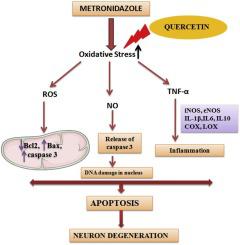当前位置:
X-MOL 学术
›
Neurotoxicology
›
论文详情
Our official English website, www.x-mol.net, welcomes your feedback! (Note: you will need to create a separate account there.)
Mechanistic exploration of quercetin against metronidazole induced neurotoxicity in rats: Possible role of nitric oxide isoforms and inflammatory cytokines.
NeuroToxicology ( IF 3.4 ) Pub Date : 2020-03-06 , DOI: 10.1016/j.neuro.2020.03.002 Swati Chaturvedi 1 , Mohd Yaseen Malik 1 , Mamunur Rashid 2 , Sandeep Singh 1 , Virendra Tiwari 3 , Parul Gupta 4 , Shubha Shukla 3 , Sarika Singh 4 , Muhammad Wahajuddin 2
NeuroToxicology ( IF 3.4 ) Pub Date : 2020-03-06 , DOI: 10.1016/j.neuro.2020.03.002 Swati Chaturvedi 1 , Mohd Yaseen Malik 1 , Mamunur Rashid 2 , Sandeep Singh 1 , Virendra Tiwari 3 , Parul Gupta 4 , Shubha Shukla 3 , Sarika Singh 4 , Muhammad Wahajuddin 2
Affiliation

|
AIM
Metronidazole, a nitroimidazole derived antibiotic used to treat many bacterial infections, is reported to penetrate the blood brain barrier after long term administration resulting into neuronal toxicity. Further, quercetin, a polyphenol flavonoid is reported to exhibit neuroprotective activity but its pharmacodynamics interaction against metronidazole induced neurotoxicity. Therefore, the present study was designed to evaluate the postulated mechanism of metronidazole induced neurotoxicity and potential neuroprotective role of quercetin.
MAIN METHODS
Animals (Sprague Dawley) rats were randomly divided into five groups such as control, metronidazole (135 mg/kg), quercetin (100 mg/kg), metronidazole (135 mg/kg) + quercetin (50 mg/kg), and metronidazole (135 mg/kg) + quercetin (100 mg/kg). The brain tissues were evaluated for tissue cyclo-oxygenase, lipoxygenase, nitrite levels, inflammatory and antioxidant biomarkers. The brain tissues were further scrutinized histopathologically for neuronal degeneration. Western blotting analysis was performed for the localization of protein expression for Bax, Bcl2, iNOS, eNOS and caspase-3.
KEY FINDINGS
The metronidazole significantly alters the antioxidant levels, inflammatory mediators and morphological changes in the brain tissue. Metronidazole also induces iNOS, Bax and caspase 3 protein expressions whilst decreases the expression of Bcl2 and eNOS in the brain tissue. Metronidazole administration causes a momentous increase in tissue inflammatory markers.
SIGNIFICANCE
The metronidazole (oral) administration causes remarkably neurotoxicity effects and the same could be attributed to the fact that metronidazole has the ability to cross the blood brain barrier and transforms the enzymatic activity of various biomarkers present in the brain. From the results, it could be hypothesized that metronidazole causes neurotoxicity by hindering the proportion of antioxidants in the brain tissue and inducing nitric oxide synthesis along with apoptosis. However, quercetin demonstrated a significant protective effect on neuronal toxicity precipitated through metronidazole.
中文翻译:

槲皮素对甲硝唑诱导的大鼠神经毒性的机制研究:一氧化氮亚型和炎性细胞因子的可能作用。
AIM甲硝唑是一种由硝基咪唑衍生的抗生素,用于治疗许多细菌感染,据报道,长期给药后会穿透血脑屏障,导致神经元毒性。此外,据报道槲皮素,一种多酚类黄酮,具有神经保护活性,但它对甲硝唑的药效相互作用引起神经毒性。因此,本研究旨在评估甲硝唑诱导的神经毒性和槲皮素的潜在神经保护作用的假定机制。主要方法将动物(Sprague Dawley)大鼠随机分为5组,例如对照组,甲硝唑(135 mg / kg),槲皮素(100 mg / kg),甲硝唑(135 mg / kg)+槲皮素(50 mg / kg),和甲硝唑(135 mg / kg)+槲皮素(100 mg / kg)。评估脑组织的组织环氧合酶,脂氧合酶,亚硝酸盐水平,炎症和抗氧化剂生物标志物。对脑组织进行病理组织学检查,以了解神经元变性。进行蛋白质印迹分析以定位Bax,Bcl2,iNOS,eNOS和caspase-3蛋白表达的定位。主要发现甲硝唑可显着改变脑组织的抗氧化剂水平,炎症介质和形态变化。甲硝唑还诱导iNOS,Bax和caspase 3蛋白表达,同时降低脑组织中Bcl2和eNOS的表达。甲硝唑的给药引起组织炎性标志物的瞬时增加。意义甲硝唑(口服)给药会引起明显的神经毒性作用,这也可以归因于甲硝唑具有穿越血脑屏障并转化大脑中各种生物标记物酶活性的能力。从结果可以推测,甲硝唑通过阻碍脑组织中抗氧化剂的比例并诱导一氧化氮合成以及细胞凋亡而引起神经毒性。但是,槲皮素对通过甲硝唑沉淀的神经元毒性具有明显的保护作用。可以假设甲硝唑通过阻碍脑组织中抗氧化剂的比例并诱导一氧化氮合成以及细胞凋亡而引起神经毒性。但是,槲皮素对通过甲硝唑沉淀的神经元毒性具有明显的保护作用。可以假设甲硝唑通过阻碍脑组织中抗氧化剂的比例并诱导一氧化氮合成以及细胞凋亡而引起神经毒性。然而,槲皮素对通过甲硝唑沉淀的神经元毒性显示出显着的保护作用。
更新日期:2020-03-06
中文翻译:

槲皮素对甲硝唑诱导的大鼠神经毒性的机制研究:一氧化氮亚型和炎性细胞因子的可能作用。
AIM甲硝唑是一种由硝基咪唑衍生的抗生素,用于治疗许多细菌感染,据报道,长期给药后会穿透血脑屏障,导致神经元毒性。此外,据报道槲皮素,一种多酚类黄酮,具有神经保护活性,但它对甲硝唑的药效相互作用引起神经毒性。因此,本研究旨在评估甲硝唑诱导的神经毒性和槲皮素的潜在神经保护作用的假定机制。主要方法将动物(Sprague Dawley)大鼠随机分为5组,例如对照组,甲硝唑(135 mg / kg),槲皮素(100 mg / kg),甲硝唑(135 mg / kg)+槲皮素(50 mg / kg),和甲硝唑(135 mg / kg)+槲皮素(100 mg / kg)。评估脑组织的组织环氧合酶,脂氧合酶,亚硝酸盐水平,炎症和抗氧化剂生物标志物。对脑组织进行病理组织学检查,以了解神经元变性。进行蛋白质印迹分析以定位Bax,Bcl2,iNOS,eNOS和caspase-3蛋白表达的定位。主要发现甲硝唑可显着改变脑组织的抗氧化剂水平,炎症介质和形态变化。甲硝唑还诱导iNOS,Bax和caspase 3蛋白表达,同时降低脑组织中Bcl2和eNOS的表达。甲硝唑的给药引起组织炎性标志物的瞬时增加。意义甲硝唑(口服)给药会引起明显的神经毒性作用,这也可以归因于甲硝唑具有穿越血脑屏障并转化大脑中各种生物标记物酶活性的能力。从结果可以推测,甲硝唑通过阻碍脑组织中抗氧化剂的比例并诱导一氧化氮合成以及细胞凋亡而引起神经毒性。但是,槲皮素对通过甲硝唑沉淀的神经元毒性具有明显的保护作用。可以假设甲硝唑通过阻碍脑组织中抗氧化剂的比例并诱导一氧化氮合成以及细胞凋亡而引起神经毒性。但是,槲皮素对通过甲硝唑沉淀的神经元毒性具有明显的保护作用。可以假设甲硝唑通过阻碍脑组织中抗氧化剂的比例并诱导一氧化氮合成以及细胞凋亡而引起神经毒性。然而,槲皮素对通过甲硝唑沉淀的神经元毒性显示出显着的保护作用。


























 京公网安备 11010802027423号
京公网安备 11010802027423号